Having just shot my two week Hokkaido Landscape Tour and the first of my two Japan Wildlife Tours with the Canon EOS R, today I’m going to share my thoughts on Canon’s first full-frame sensor mirrorless camera offering.
Let’s get this out there right away, as I know many of you are eager to hear my overall verdict; with a total of four weeks of shooting with the EOS R from dawn till dusk each day, I am happy to tell you that I have fallen absolutely head-over-heels in love with the Canon EOS R camera and RF 24-105mm lens.
There are lots of reviews out there panning the EOS R, and because of that, this was probably the most cautious gear purchase I’ve made for a while, but I can honestly say that my concerns were pretty much completely unnecessary. I’m not saying that this is the best mirrorless camera on the market right now, but if you are a Canon user, looking for a way to gradually move over to mirrorless, Canon has now put the first stepping stone in place, and it gives us a very firm footing, as I’ll explain.
Not Perfect, But Close…
That said, it has one major issue and a number of other areas that need work, but as Canon’s first full-frame sensor mirrorless camera, it has way surpassed my expectations, to the point that I avoided using my Canon EOS 5Ds R bodies as much as possible during the last two tours. It’s not that the 5Ds is all of a sudden a bad camera, but the EOS R is more fun to use, and the image quality is spectacular, to the point that I didn’t really mind working harder to overcome the problems that I did have, and I’ll share details of these shortly.
Basic Specs
You can see full details on the Canon website, but to touch on the key specs, the EOS R has a 30.3MP Full-Frame CMOS Sensor with a DIGIC 8 Image Processor. It supports 4K video, the first camera I’ve owned that does after my iPhone, and it has Dual Pixel CMOS Autofocus, with an amazing 5655 Autofocus Points!
The EOS R sports a 3.69m-Dot Electronic Viewfinder and 3.15″ 2.1 million-dot swivel touchscreen LCD, which is also a first for me. The ISO can be expanded up to 102400, and in burst mode, it shoots a very respectable 8 frames per second.
Real-World Examples
Before I go on to explain more about the few problems I did have, and provide my wish-list for this and future Canon Mirrorless cameras, let’s
Winter Landscapes
It won’t come as a surprise that a mirrorless camera works fine for Landscape work, but I’ll share a few images from my Hokkaido Winter Landscape Photography Adventure Tour to make a few points.
The first one is a comparison that I did between the EOS R and the 5Ds R. With my tripod in the same place, I switched out the cameras to make two identical photographs of this scene, which I shot with the EOS R and the RF 24-105mm lens.
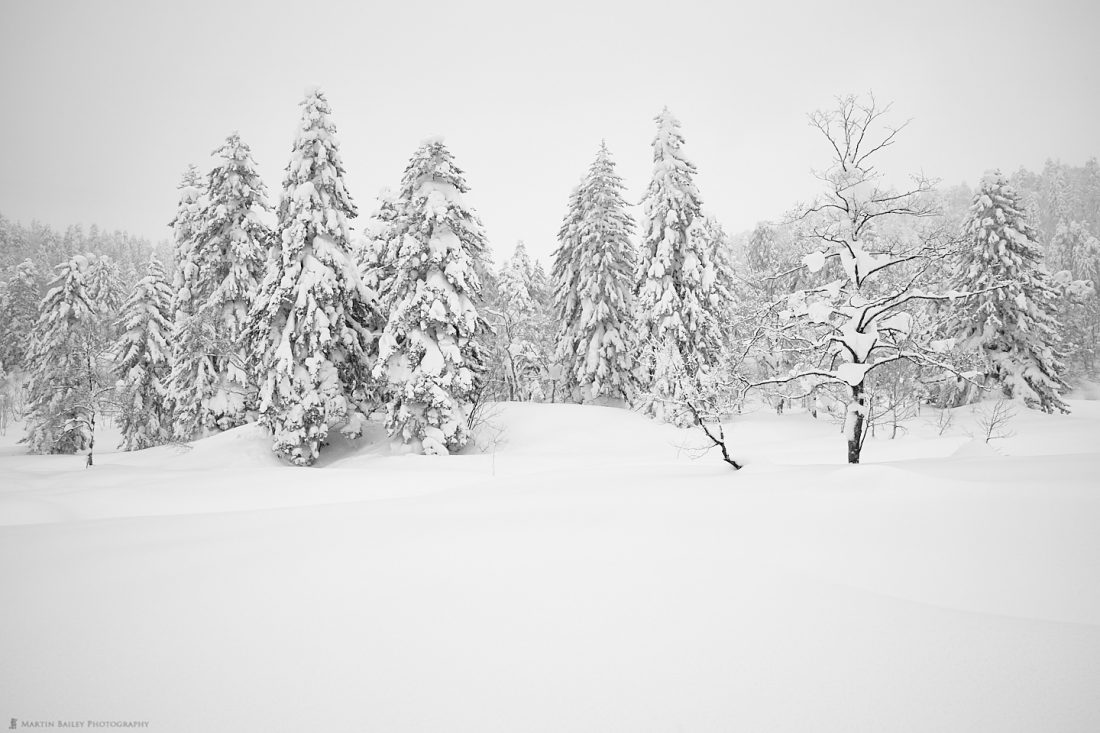
EOS R and 5Ds R Image Comparison
Although when comparing a 30-megapixel image with a 50-megapixel image, the 50-megapixel shot obviously has more resolution,

If you can’t see the detail on the Web page, click the image to open up the larger version, or consider subscribing to our MBP Pro membership to get access to the eBook with high-resolution images for this post.
Snow is Fine Sometimes
Another image that I wanted to share from the landscape trip is to segue to the first and main issue that I have with the EOS R. Here, is an image that I shot in the snow, with the RF 24-105mm lens.

And here is a photo of my EOS R with a decent amount of snow on it, as I shot the previous image. The snow melted occasionally on the top around the LCD and buttons, and I wiped it off from time to time because I don’t trust the weather-sealing on any Canon camera that is not 1-series.
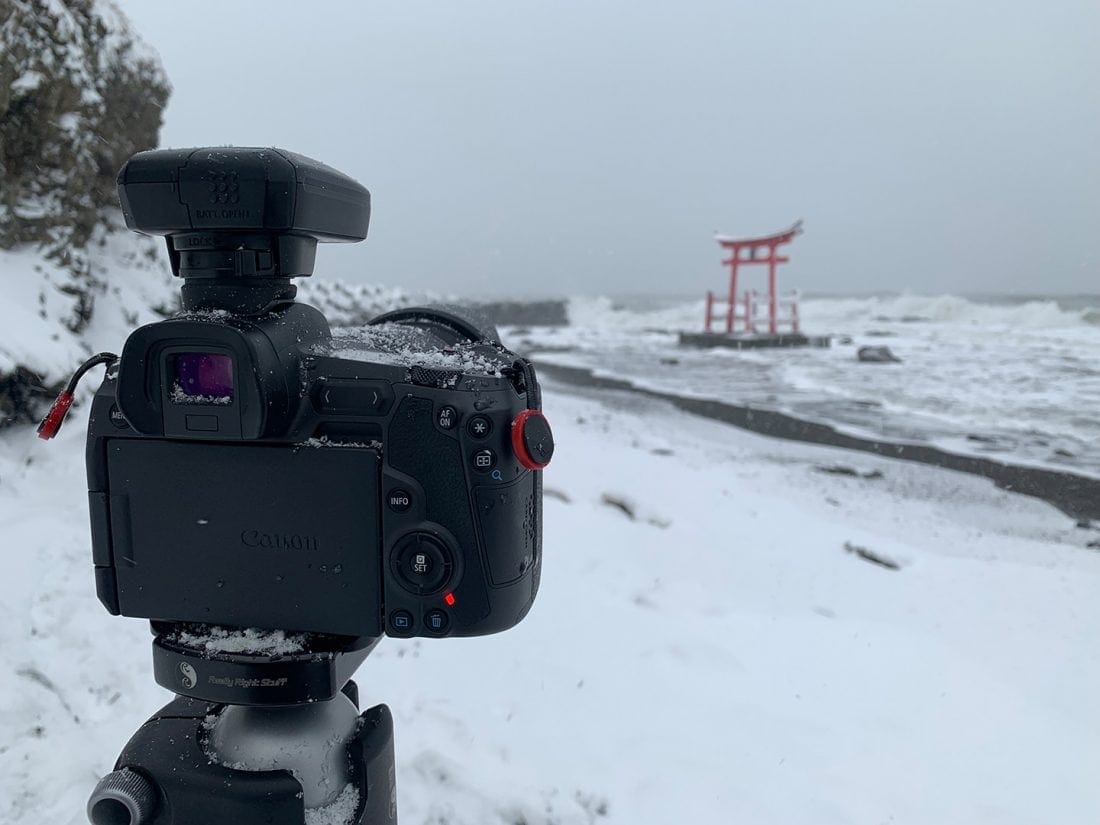
It’s actually quite annoying that Canon use marketing terminology that would have you think that the EOS R is weather-sealed. Here is a quote from the Canon USA website:
Dust & Water-resistant Sealing (from Canon’s Website)
The EOS R camera is designed for use in a variety of weather conditions. Sealing materials are used in critical areas like the buttons, terminal covers, the battery compartment and the card slot cover. Precise design and construction help to minimize accidental penetration of dust and moisture in the rest of the camera body. Combined with an RF lens, or any other weather-sealed EF/EF-S lens, the EOS R proves to be a reliable partner in virtually any climate.
Don’t Believe the Marketing Blurb
There is also an image that shows the EOS R’s weather-sealing, and you’d think from this text and looking at the graphic that the EOS R is weather-sealed, but I can assure you that it is not. Why? Because when you use the EOS R with a long lens that makes the camera sit at an angle, with the viewfinder pointing upwards, even a relatively small amount of snow falling on the eyepiece will make it do this.
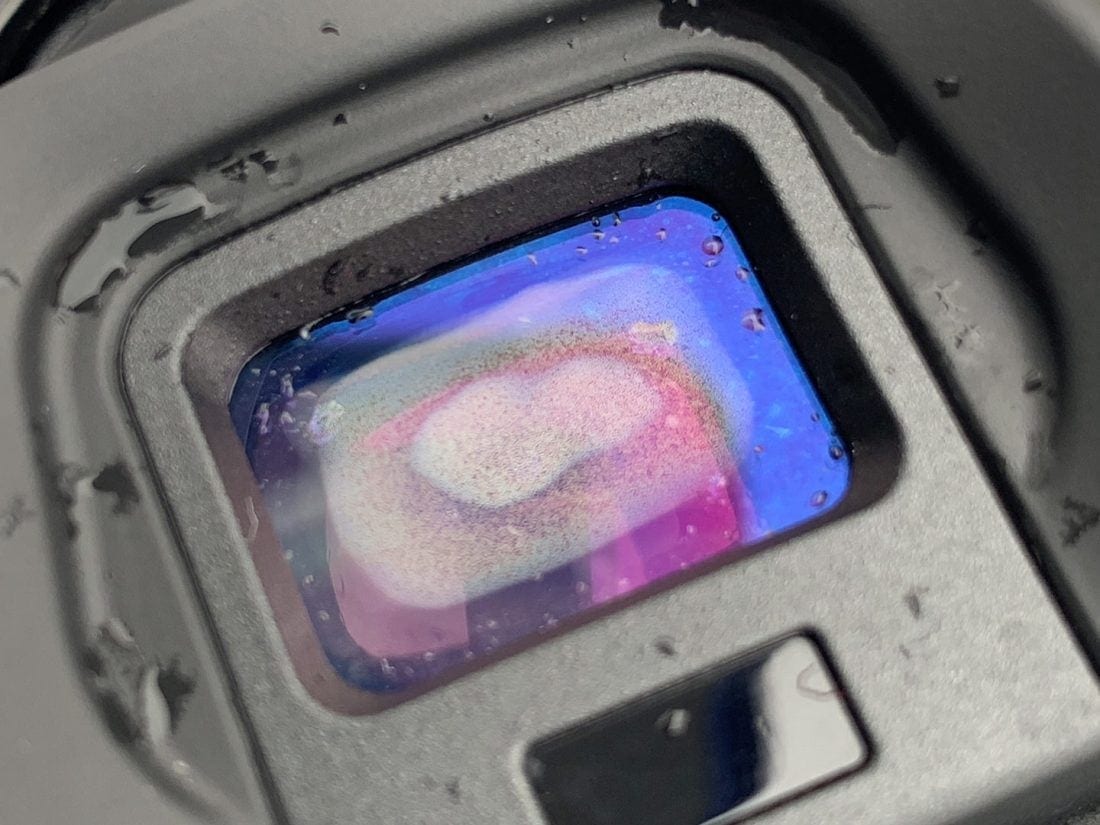
This photo was from a few weeks after my Landscape tour, when I was on my first Japan Winter Wildlife tour of this season. I was shooting with the 100-400mm lens and got a little, definitely not a lot of snow, on the back of the camera and the viewfinder, and within minutes, the inside of the viewfinder fogged up like this.
I had decided to take just the EOS R to photograph the Snow Monkeys, and I’ll share some images in a moment, but on the main full day, when it snowed the entire day, the viewfinder fogged shortly after I started shooting, and then in the afternoon, I got the second layer of condensation that you can see in this photograph, which formed over the first. I literally had to shoot the entire day looking through the small gap at the top or bottom of the fogged area of the viewfinder.
It Happened More Than Once
A week later, the next time I used the EOS R in the snow, literally within five minutes, it fogged up again, as you can see in this photograph.
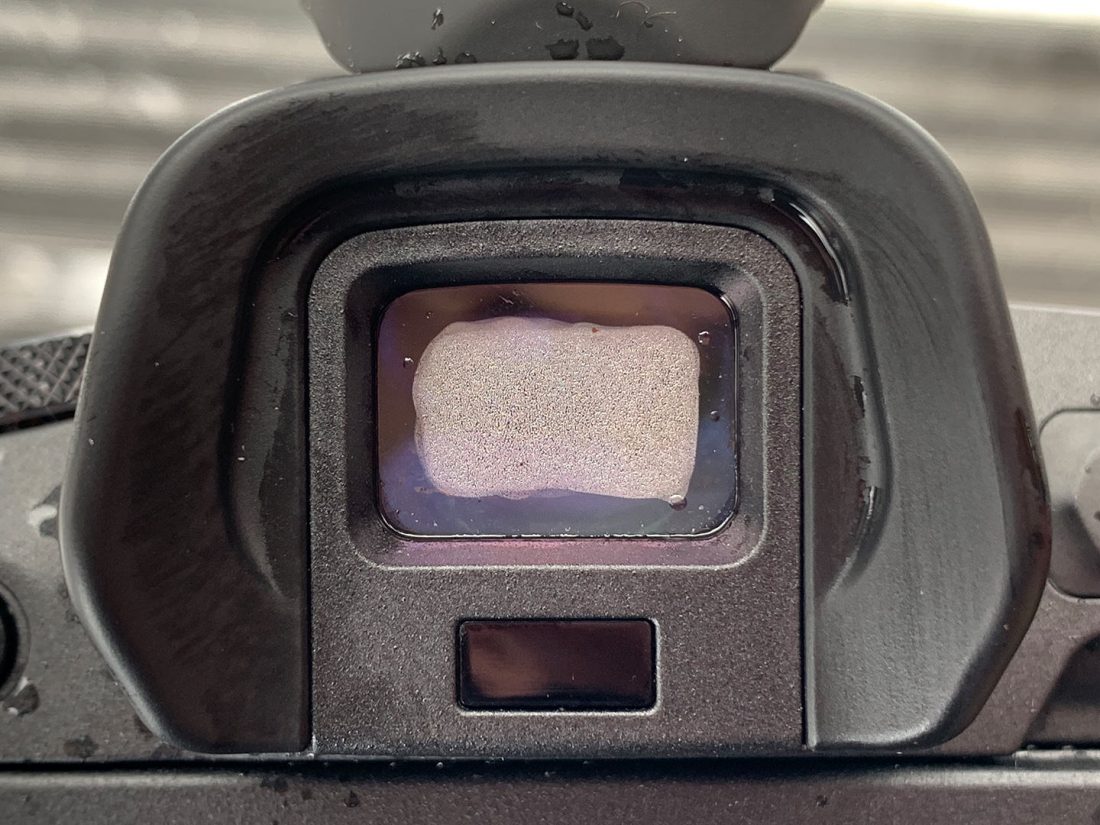
Seriously, I had the camera in the snow for around five minutes, to shoot our group photo for the tour, and as soon as the snow hit the back of the camera, it fogged up. The temperature on both occasions was probably around -5°C or 23°F, and granted, Canon only say that their cameras will work between 0-40°C or 32-104°F, but if we really couldn’t use these cameras when it goes below freezing, I for one would stop buying Canon cameras, and I know that I’m not alone on this.
Double Take
And what does that say for the last sentence of the quote I just included from Canon’s marketing blurb? “The EOS R proves to be a reliable partner in virtually any climate.” Is below freezing really not included in such a bold statement?
I would also like to add that the EOS R actually works very well in the cold. On two consecutive mornings on the wildlife trip, I used the camera at -23°C and -25°C, which is -9°F and -13°F respectively, and there were absolutely no problems at all. No fogging, no problem with the battery, nothing. It just worked, so cold is not a problem. It’s snow that is the problem, regardless of the fact that Canon shows a diagram with weather sealing around the viewfinder in their marketing materials.
This, mind you, was the only serious issue I had with the Canon EOS R camera, so rant over. I’ll get off my soap-box now, and we can look at a few more example images, and we can come back to the other few issues after that.
A Walk on the Wild Side
So, landscapes are fine, and I doubt that anyone ever thought they would not be. But how about wildlife? When I first got the EOS R one of the first things I did was have my wife walk around erratically so that I could see how well the autofocus kept up with her. I was pleasantly surprised that it seemed to do a pretty good job.
It has, of course, been the main problem with mirrorless cameras, that the autofocus isn’t quite as snappy as our DSLR cameras, and that was my main reason for holding off buying one, until now. Well, I’m happy to say that the autofocus itself is great, but it takes a lot of getting used to tracking a moving subject in a viewfinder that essentially becomes stroboscopic as soon as you start shooting in burst mode.
I really like to stand in a certain place at the Snow Monkey Park in Nagano, Japan, and wait for the monkeys to come running down the mountain, as we can see in this photograph.
When I first starting shooting this kind of image though, it was really hard to keep the monkey in the frame while tracking them with the AI Servo, because even with the camera’s Display Performance set to Smooth, which is supposed to make “Quick-moving subjects display smoothly”, quoting the note in the menu.
Of course, when just moving the camera with the subject in the viewfinder, they are relatively smooth, but then as soon as you start shooting in burst mode, you have to track the subject by watching a series of still photographs, almost like watching them move around under stroboscopic light.
Note too that I have turned off the preview so that I am not presented with the photo that I just shot, so I’m really just seeing the camera’s best effort to track and display a moving subject while shooting and recording images in burst mode.
My Tracking Settings
I did find it necessary to tweak my Autofocus Tracking settings, for the first time in many years, to get the most out of the EOS R for wildlife photography, including birds in flight. Here are the settings that I settled on.

I reduced the Tracking Sensitivity to -2 to help keep the camera locked on to a moving subject. I increased the Acceleration/Deceleration Tracking to +1, to stay with an erratically moving subject, and I generally tend to leave the AF Point Auto-Switching at zero, because increasing this can make the autofocus jump to the background or things that cross in front of your intended subject a little too easily.
You Get Used to it!
The cool thing is though, although it was difficult to track a moving subject with the EOS R at first, as I tweaked my settings I did also find you do get used not being able to see the subjects every move, and after my first hour or so struggling, before too long I was nailing shot after shot where I had to focus relatively quickly on a moving subject, and then rely on the camera to accurately track it.
Occasionally the camera simply will not focus, and it stays out of focus until you stop focusing and try again, quite often taking so long to gain focus again that you miss the shot completely. I’d say that after two weeks of shooting wildlife like this every day, that happens maybe once with every 20 or 30 bursts. If you have just one chance to photograph something, honestly the EOS R is not for you, but if you will have multiple chances, and don’t mind losing a few opportunities, it’s totally workable.
Control Ring Mount Adapter EF-EOS R
To mount EF lenses to the RF mount, Canon has released a number of adapters, and I bought the Control Ring Mount Adapter which, as the name suggests, has a built-in Control Ring, and it comes in a nice little case, to protect it when you aren’t using it.

You can program the Control Ring to do a variety of things, and I have set mine to enable me to change the ISO by rotating the Control Ring, and that applies not only to the Control Ring on the Mount Adapter but also the one that is built into all RF lenses.
100-400mm Lens with Mount Adapter
I shot most of the wildlife during my two-week tour using the 100-400mm lens attached to the EOS R with the Mount Adapter. I also used it with the 200-400mm with the built-in 1.4X Extender, and during the landscape workshop with the 11-24mm EF lens. It works great with all the lenses.
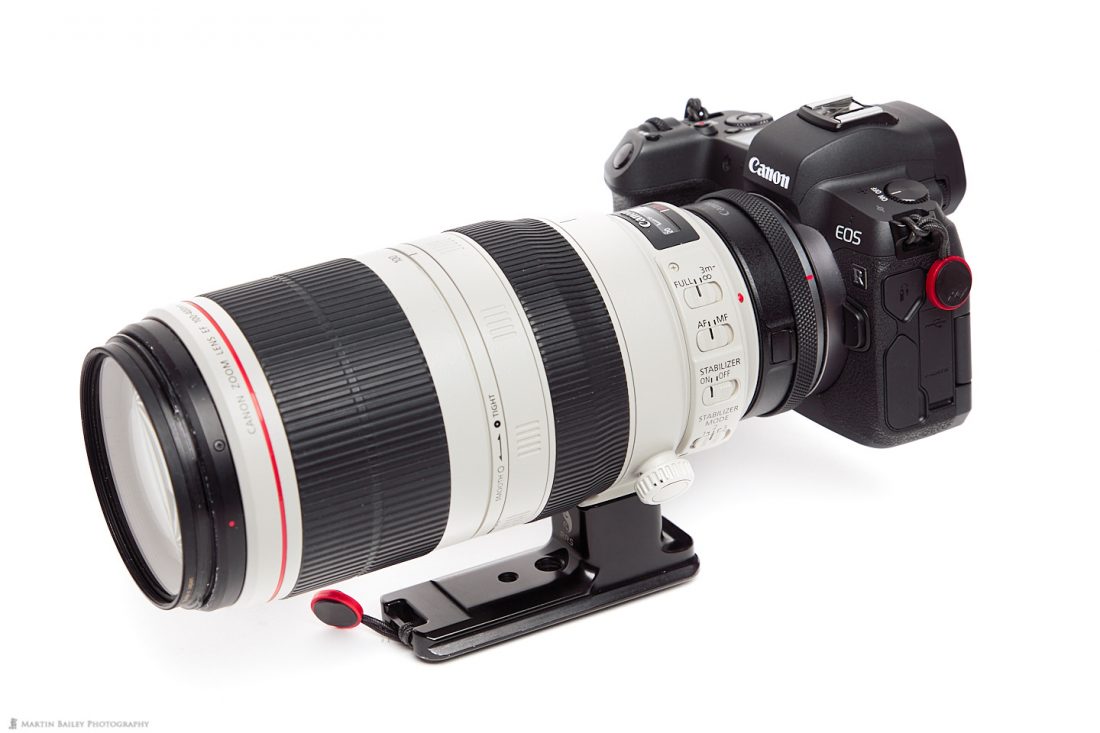
Sharp Sea Eagles
I went on to Hokkaido and had no problems photographing birds in flight with the EOS R, but right until we actually started photographing the Sea Eagles at Rausu, I honestly thought that the EOS R would not be able to cope with how I photograph the eagles.
Basically, so that I can wait until I see the actual eagle that is going to try and snatch the fish out of the water, I don’t track with the birds before the catch. I literally wait until one eagle is almost on the fish, then frame it up, and snap the focus in at the last minute before releasing the shutter.
I had thought that the EF 100-400mm Mark II with the Control Ring Mount Adapter was going to be too slow to focus, despite me now having had a week of practicing shooting wildlife with the EOS R. Well, I am happy to say that I was completely wrong! The camera and lens performed admirably, and I was able to bag hundreds of eagle shots that were perfectly in focus and sharp as tacks.
Here is a shot of a Steller’s Sea Eagle as he reaches out with his talons shortly before pulling the fish out of the sea. This is literally a moment after I framed the bird up and focussed on it.
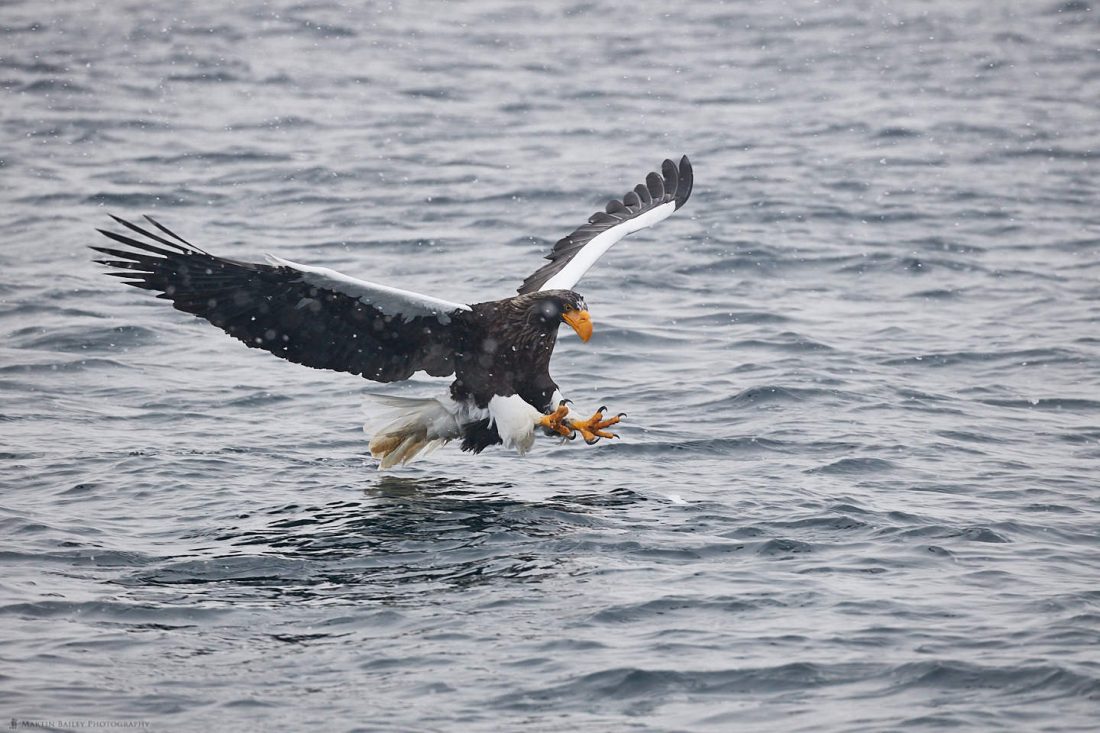
This photo is not cropped and has a little bit of Clarity applied in Capture One Pro, but that’s all. I’ve done nothing else to it.
Steller’s Sea Eagle Pulling Fish from Sea
Although the EOS R is supposed to have a frame rate of 8 frames per second, I set it up to give preference to achieving focus, rather than just firing away regardless, and this slows the camera down slightly, but generally, for these bursts, I get two to three images. The frame after the previous image is this one, as the eagle pulls the fish from the sea.
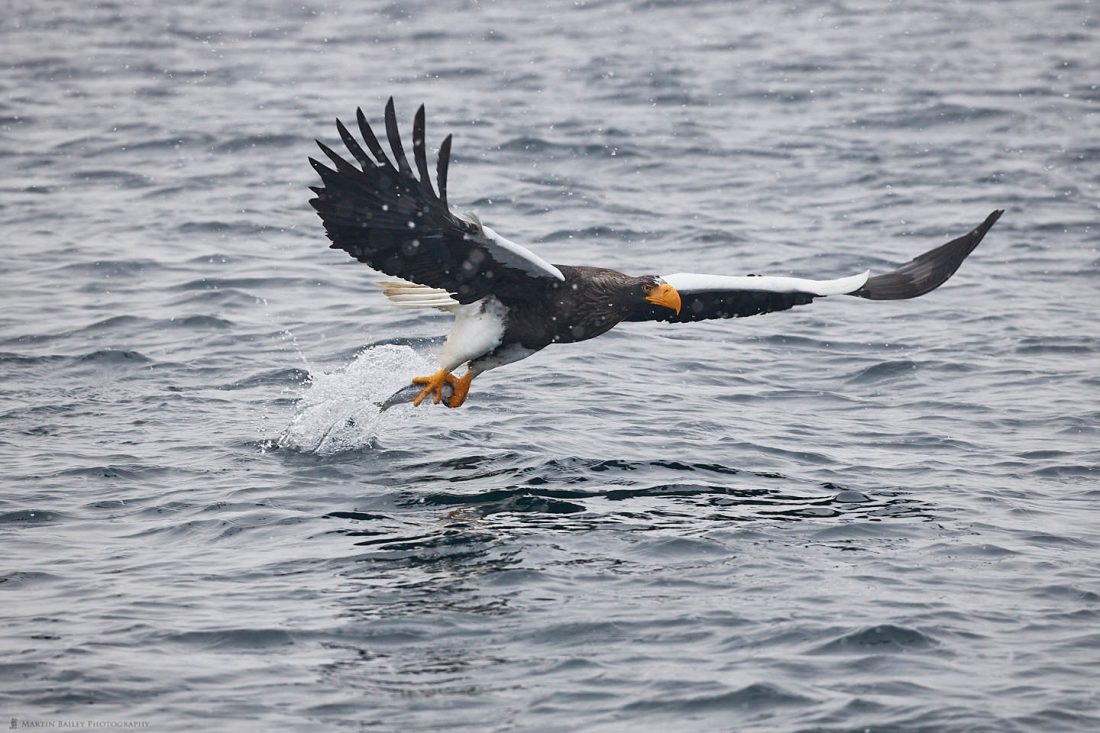
Again, this is not cropped and has just had a little bit of Clarity applied. My settings were 1/1600 of a second at f/9, with the ISO set to 1600, and I had my 100-400mm lens zoomed all the way in to 400mm.
I really was incredibly happy to find that I could shoot the eagles just as I have been with my 5Ds R, because to me, this is my ultimate test of the robustness of the autofocus system on a camera.
Happy to Go Completely Mirrorless with Canon
If I couldn’t get shots like this, I’d need to own different types of camera bodies for different purposes, and when you travel overseas to do lots of different types of photography, it makes life so much easier if you can just take two identical bodies. More importantly, if I can shoot images like this, I know that I would now be happy to go completely mirrorless with Canon as they release future bodies.
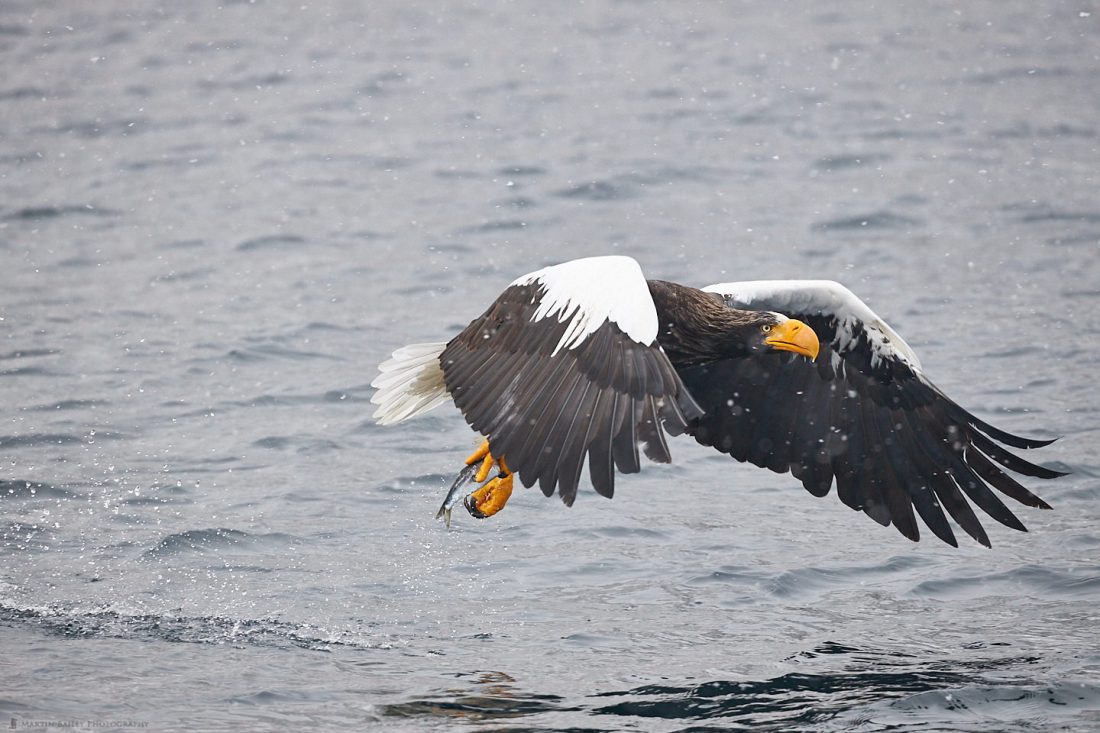
Here is a 100% crop to show just how sharp the image is, and again, this is with the EF 100-400mm Mark II lens attached to the EOS R with the RF Mount Adapter.

Actually, the version embedded in the blog post is slightly smaller than the 100% crop. To see it pixel for pixel, click on it to open the lightbox viewer.
It Works, But it isn’t Easy!
So, to summarize my experience with the EOS R for fast-paced wildlife shooting, it works, but I’m going to go out on a limb here and say that this is not going to apply to everybody. I know this will sound conceited, but I am an experienced photographer and I’ve been shooting this sort of wildlife work with the 50-megapixel Canon EOS 5Ds R for the last three years.
Many people say that you can’t shoot wildlife with the 5Ds R and it’s given me great pleasure to prove those people wrong, but at the same time, I do appreciate that a lot of it is down to my skill and experience. I would say that if you want to shoot wildlife with the EOS R, don’t make it your first camera. You’ll want to own and be proficient at shooting wildlife with a DSLR before you consider using this camera. I’d say the same would go for sports photography. It works, but it isn’t easy.
Wrap-up for Now
OK, so we’ll wrap up this review for now, and continue next week with the second part. Before we close I’d like to mention that I was not enabled by Canon or any other third party in the making of this review. I paid full price for all of the Canon gear mentioned, and my comments are not influenced by any external forces.
As part of my business, I rely on affiliate payments when visitors click on links in posts, and this helps us with the upkeep of the website and to pay for my time, while costing you nothing. If you found what I’ve provided here useful, I’d really appreciate it if you use the links provided, assuming of course that you will be buying from our friends at B&H Photo.
Part two will be released tomorrow, so please check for a link to the second part below if you are visiting after February 17, 2019.
Show Notes
See the EOS R on B&H Photo: https://mbp.ac/eosr
Here too is the RF 24-105mm Lens: https://mbp.ac/rf24-105
And you can buy both together as a kit here: https://mbp.ac/EOSR24105Kit
Canon BR-E1 Wireless Remote Control: https://mbp.ac/BRE1
Canon Control Ring Mount Adapter: https://mbp.ac/ccrma
Audio
Subscribe in iTunes to get Podcasts delivered automatically to your computer.
Download this Podcast as an MP3 with Chapters.
Visit this page for help on how to view the images in MP3 files.

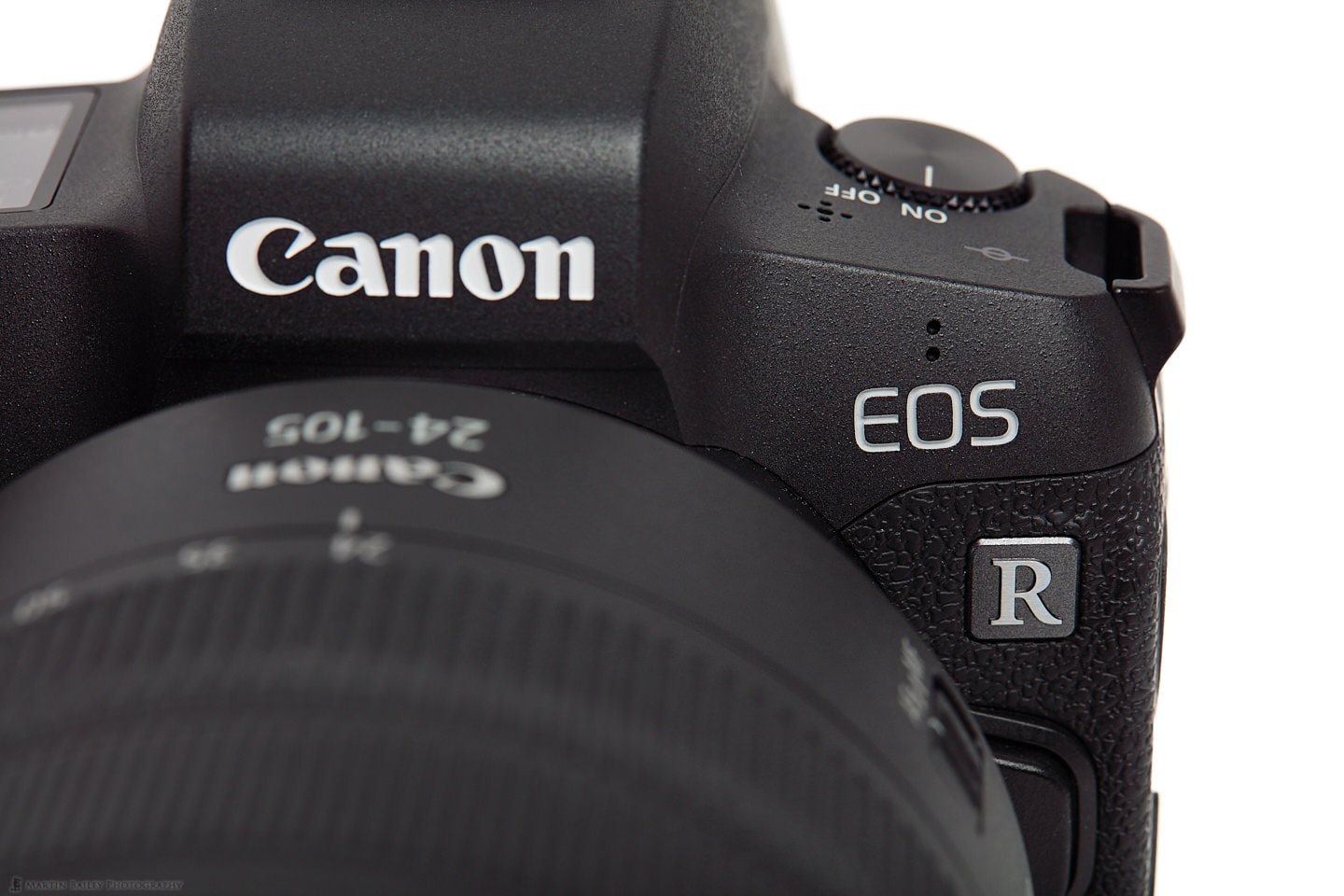
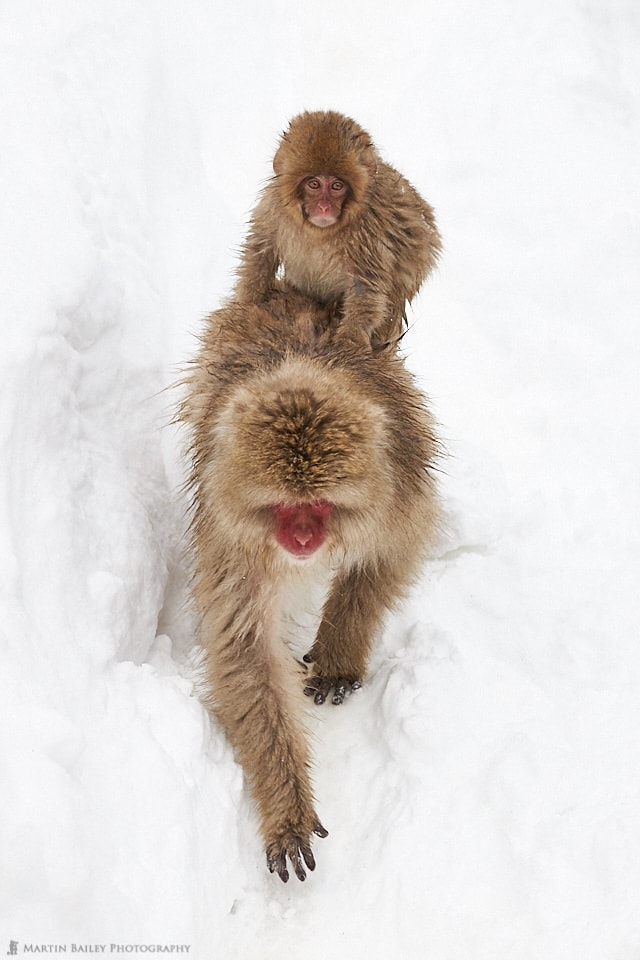

https://www.fredmiranda.com/forum/topic/1583716
Hello. This post seems to think its not “leakage” but condensation. What do you think of that theory?
useful, beautifully
illustrated review
and nice tips 🙂
It’s not condensation in the normal sense at least. I’ve experienced condensation going from very cold to warm with other cameras. But I experienced the exact same thing with my R recently. Carrying it with a BlackRapid strap makes the EVF point up, it was very light rain and I had been out for while, no fog in the EVF. After 10-15 minutes with only some raindrops hitting the camera I saw the same thing as described in the article.
Hi Viggo,
Yes, that’s exactly the same thing. Moisture is probably a better way to describe it, but the result is that you can’t see through the viewfinder, so I’m not going to split hairs over the verbiage.
Regards,
Martin.
Hello really useful info. I realise this may be a little late to ask, but can you tell me how does the water disappate if it has penetrated the evf where does it go and how long does it take to clear, I was looking into buying one specifically as it would be more weather sealed than my current camera. thanks.
Hi Sarah,
It depends on the conditions. Once you get the EOS R out of the snow etc. it clears in an hour or so, but I had to use it almost completely fogged up as you see in the above photos for up to a day when I first got it.
As for where the moisture goes, it just disappears, probably going out the same gaps in the sealing that it got in through.
Although the EOS R is a great camera in almost every other respect, its tendency to fog up like this was a concern on many shoots, and this was never addressed by Canon, so I can’t really recommend the EOS R if you are going to use it in wet conditions.
I don’t know if the EOS R5 is going to be any better, although the diagrams Canon have released do show more weather-sealing. Fingers crossed!
Regards,
Martin.